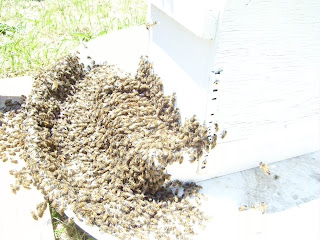written by Yvonne
We had a weekend or two of relative rest, but all good things, as they say ... . This weekend we had several things to get done. Tom picked some mint from his bee mentor's house, so we had to find a location to plant it. Since we put lavender and lemongrass in what was going to be the mint patch, we looked around for a new spot. The space along the back fence has been relegated to bee-friendly items and/or things that need partial shade. That seemed like a good spot so Tom started clearing an overgrown area along the fence, behind the compost bins.
He used a brand new hatchet his mom picked up for him to help with the job.
Here is the mint before planting...
and here it is in its new home. It smells lemony.
Now for some beauty shots.
Peas have finally blossomed.
Blackberries.
Blueberries.
Beans that were planted just last week!
We each went to town on various projects that need completing. I was in charge of fertilizing the berries, ripping out BIG weeds from the berry area, and getting a green-up tonic together for the rest of the garden. A tonic is one of the things Jerry Baker recommends in his books. The green-up tonic I concocted today consisted on beer, ammonia, plant food, Karo syrup and dish soap. We have measuring spoons and cups and all of the ingredients in our out building so we can whip up what we want without having to go in and out of the house.
Tom (and Olive) turned the compost, added leaves, and 120 pounds of kitchen scraps.
Olive and I prepared bed #3 for a good bit of summer crops. I took one last harvest of collards and then pulled them out. I did a quick turn of the soil, pulled out some weeds, and planted bell peppers, oregano, tomatoes, cucumbers, and marigolds.
Tom had a full bin of leaves ready to use as mulch, so he loaded up the garden cart and brought plenty over to the potato/onion bed.
Some random dill (the fluffy green stuff I'm hoeing around) peaked up recently. At first, we didn't think it was any good because it didn't smell like dill. I pulled up one small plant to get rid of it and found it to be VERY fragrant after all. So I carefully moved all of them over to make room in this spot for Holy Mole peppers. We didn't plant these type of pepper last year so it will be a new experience.
Tom tilled the pumpkin patch from last year (which never did produced any pumpkins) and sowed some melon seeds. (Has anyone noticed that I've been in the blazing sun in all these pictures while Tom is cooling it in the shade? Who came up with the distribution of jobs today do you suppose?)
Tom still futzing around with his hive bases. He's waiting not so patiently for his bees to arrive. Maybe by next week's posting. The anticipation is driving him c-r-a-z-y.
After getting cleaned up and getting a bite of lunch, it was on to more projects. Tom (and Olive) worked on building more frames for a second hive.
I had lots of reading to do.
Below are two web sites we want to share with everyone. The Truck Farm we find quite interesting and Ruth Stout we find quite inspirational. Be sure to watch both videos (1 of 2 and 2 of 2) of Ruth Stout.
Truck Farm (www.truck-farm.com)


















































